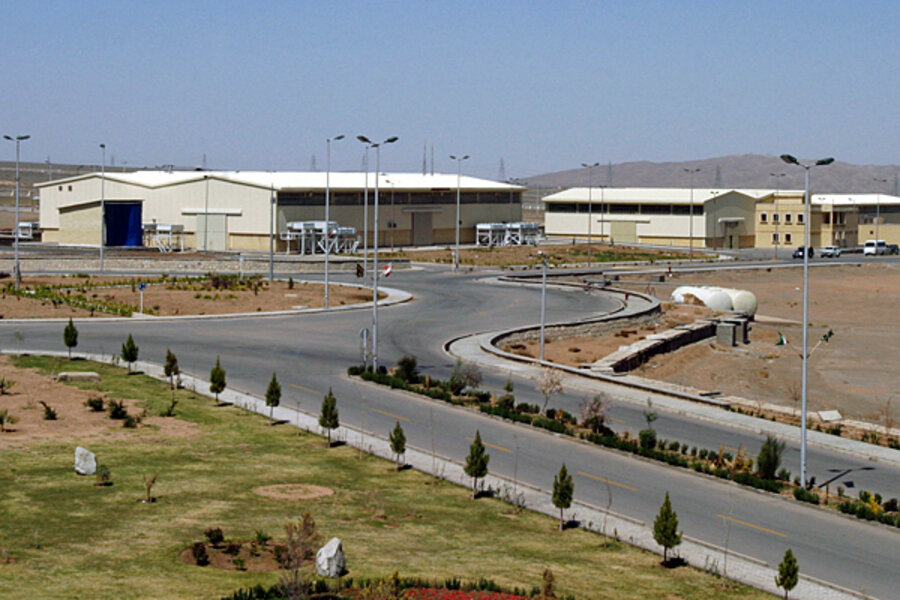Why Iran left the US off invite list for tour of nuclear sites
Loading...
| Istanbul, Turkey
Iran has invited diplomats to visit its nuclear facilities, but left America and key European nations off the guest list ahead of the next round of nuclear talks slated for later this month in Istanbul.
In an apparent bid to magnify divisions in the international community and thus ease sanctions over its controversial nuclear program, Iran has invited Russia and China – two of the six world powers involved in the talks, which have shown most reluctance to increase pressure on Iran – to tour nuclear sites in mid-January.
But not included were four key members of the P5+1 negotiating group that have been most critical of Iran. The US, Britain, France, and Germany claim that Iran wants to build nuclear weapons behind the facade of a peaceful power program.
“The Iranians are always trying to divide the coalition, and I think the point of the meetings [for the Iranians] is not to resolve the problem, but to deflect pressure for more sanctions, by demonstrating that Iran is not recalcitrant,” says Shahram Chubin, an Iran nuclear expert with the Carnegie Endowment based in Geneva.
“The Russians and the Chinese like to have any excuse not to go to the next step, or indeed to implement the current steps, and the Iranians play on that,” says Mr. Chubin, author of a 2006 book about Iran's nuclear efforts. Iran’s tactic is to “delay and prevaricate and divide, and it's always in response to pressure, despite what it says. Of course, that [pressure] is exactly the only way you can get the Iranians to focus.”
Also invited were Hungary, which now holds the rotating presidency of the European Union, Egypt, Cuba, the Arab League, and the Non-Aligned Movement. Iran’s Foreign Ministry spokesman Ramin Mehmanparast said that Iran wanted to show “cooperation with the IAEA,” the United Nations’ nuclear watchdog agency.
Tour to include Bushehr, Natanz
Iran is currently under four sets of UN Security Council sanctions and a host of separate US and European measures, which have begun to bite into its ailing economy. Those sanctions require Iran to halt uranium enrichment until it can resolve remaining questions about possible weapon efforts with the International Atomic Energy Agency (IAEA).
Iranian officials said the tour would include meetings “with high-ranking officials” in Iran, according to the Dec. 27 invitation seen by the Associated Press. Iran’s conservative leaders have stated repeatedly that they will not stop enrichment under any circumstances, though other steps may be discussed.
“Acts such as Iran’s invitation to several countries to tour its facilities are not a substitute for Iran fulfilling its obligations to cooperate with the IAEA and will not divert attention away from the core issues regarding Iran’s nuclear program,” said Mark Toner, a spokesman for the US State Department.
The tour would include Bushehr, the Russian-built nuclear power reactor on the southern coast of the Persian Gulf that is due to start up this month after years of delays. It would also include Natanz, the central city where Iran has installed underground nearly 9,000 centrifuges to enrich uranium, though technical difficulties, including the malicious Stuxnet computer worm, appear to account for the fact that only half have been operating.
The entire program was also inexplicably shut down for a time in November, according to the IAEA’s latest quarterly report.
Nuclear talks with Iran began again in December in Geneva after a 14-month hiatus, and Iranian officials portrayed the result as a “victory” for Iran by making no compromises. Still, Western diplomats say top American officials at the meeting were not disheartened, and expect some progress in Istanbul.
Nuclear swap deal?
While Iran curries favor with allied governments or important negotiators such as Russia and China, one ingredient of the Istanbul talks may be a nuclear swap deal first proposed and backed by the US in October 2009. Under the deal, Iran would have exported the bulk of its enriched uranium, to be turned into custom-made nuclear fuel.
Iran appeared to accept and then reject that deal, before it agreed to a very similar version in May 2010 with the mediation of Turkey and Brazil. That newer version was then dismissed by the US and its allies, because Iran had continued to enrich.
The issue that stopped Iranian President Mahmoud Ahmadinejad in October 2009 was a storm of domestic criticism, and “was something [Ahmadinejad] couldn’t get past [rival] pragmatic conservatives because he would have been able to brag about it. I don’t think that’s changed,” says Chubin, of Carnegie.
A US diplomatic cable written from the Turkish capital, Ankara, and released by WikiLeaks last week, appears to confirm that view. It recounts a November 2009 meeting between Turkish Foreign Minister Ahmet Davutoglu and a top American diplomat, in which the Turk says Ahmadinejad was “more flexible” than other members of the Iranian regime.
The cable reads: “Ahmadinejad is facing ‘huge pressure’ after statements from some P5 members to the effect that a nuclear deal would succeed in weakening Iran’s nuclear capability – which is interpreted by some circles in Iran as a virtual defeat.”
The cable signed by the US ambassador to Turkey, James Jeffrey, said Ahmadinejad had affirmed to the Turks that the core issue was “psychological rather than substance.”
“It’s been obvious for years now that the Iranians … aren’t going to roll it back; they’re going to keep some enrichment. The question is what level of enrichment, and what sort of inspections can we live with, and be fairly assured that they don’t go closer to the [nuclear weapon] threshold,” says Chubin. “Because that’s the whole point, to keep them as far away from the threshold as possible.”





